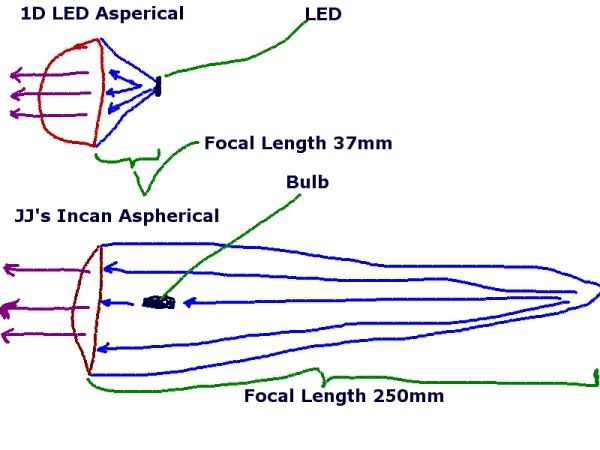jimjones3630
Flashlight Enthusiast
Have received several inquires regarding the use of precision optic lens in flash lights. Well, opened this thread first for modders who have used them to share their expectations, experience, set backs, opinions.
The asphere's more complex surface profile can eliminate spherical aberration and reduce other optical aberrations compared to a simple lens. A single aspheric lens can often replace a much more complex multi-lens system. The resulting device is smaller and lighter, and possibly cheaper than the multi-lens design.
LED modders have used aspherical lens and familiar with the critical distance set up of lens to LED and curvature of lens relationship. Often have head asphericals are for LEDs, they don't work with incandescents. Radical asphericals like fish eye types project the image of a incan. filiment and look fairly sick.
Hook's law helps classify glass types by sorting according to Young's moduli. BK7 is 82. This relates to amount of heat stress capability or specific thermal tension exist when a heat gradiant exist causing internal stress.
So much for the technical, perhaps someone with an understanding of glass properties will contribute.
This lens I found has more heat resistance than current usage borofloat or UCL windows an advantage with 100+ watt mods. Also, it focuses visible light into a culminated stream in a way I have not seen before. See pic below. The beam is a perfect circle, has more throw than with boro or UCL lens, and has usable side spill.
 2/22/08 See post #29 for ongoing evaluations of lens and recommendations in post #29. jim
2/22/08 See post #29 for ongoing evaluations of lens and recommendations in post #29. jim
The asphere's more complex surface profile can eliminate spherical aberration and reduce other optical aberrations compared to a simple lens. A single aspheric lens can often replace a much more complex multi-lens system. The resulting device is smaller and lighter, and possibly cheaper than the multi-lens design.
LED modders have used aspherical lens and familiar with the critical distance set up of lens to LED and curvature of lens relationship. Often have head asphericals are for LEDs, they don't work with incandescents. Radical asphericals like fish eye types project the image of a incan. filiment and look fairly sick.
Hook's law helps classify glass types by sorting according to Young's moduli. BK7 is 82. This relates to amount of heat stress capability or specific thermal tension exist when a heat gradiant exist causing internal stress.
So much for the technical, perhaps someone with an understanding of glass properties will contribute.
This lens I found has more heat resistance than current usage borofloat or UCL windows an advantage with 100+ watt mods. Also, it focuses visible light into a culminated stream in a way I have not seen before. See pic below. The beam is a perfect circle, has more throw than with boro or UCL lens, and has usable side spill.
 2/22/08 See post #29 for ongoing evaluations of lens and recommendations in post #29. jim
2/22/08 See post #29 for ongoing evaluations of lens and recommendations in post #29. jim
Last edited:




